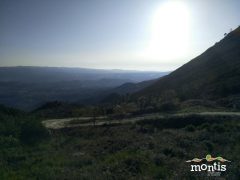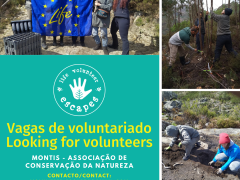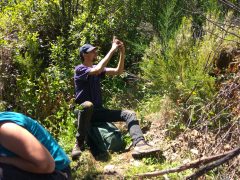
Nature conservation and restoration in Torres-Vedras
(English)
On 9th March myself and two other volunteers from LIFE Volunteer Escapes in Montis travelled down to Torres Vedras to partake in an activity led by the Municipality on Praia Azul (Blue Beach). We worked alongside a group of youngsters from an agricultural college and the Municipalities coordinators and volunteers from Life Volunteers Escapes. Also present was the filming team of PlaySolutions, who took footage of the day.
With its Atlantic location, the area surrounding Praia Azul is subject to strong winds and also flooding following tidal surges. These not only poses a risk to local inhabitants, but to agriculture and wildlife alike. The large-scale removal of sand for building projects in the past has caused one of nature’s best flood defences (the sand dunes) to diminish. This activity has now ceased, but the impacts are still being felt.
In order to mitigate the risk, the municipality has begun a series of conservation efforts to restore the dunes to their former glory! This includes planting and fostering the growth of indigenous species such as Ammophila arenaria, which help to strengthen the dunes and increase biodiversity. The use of motorbikes and other vehicles over the dunes has also been banned.
Below you will see Carpobrotus edulis, an invasive species with very few predators. If left alone, Carpobrotus edulis dominates the dunes, outcompeting the native vegetation.
We were tasked with the removal of this species. Surprisingly, the plant was fairly easy to remove from the sand when not found in abundance. Our team was also given a tour of the area, and shown indicators of the growing level of biodiversity, such as rabbit burrows and droppings.
After the beach, we got to explore a second property managed in Torres Vedras. On this site much of the pine-lands were damaged by a storm (a repetitive theme in this region!) The trees, although standing tall, were frail and susceptible to strong winds!
With stunning beach views, and an informative guide from the Municipality, the day was enjoyable and educational for all. It was interesting to hear about the conservation challenges of another type of landscape in Portugal, and to find out about the efforts going into restoration. Meeting other Life Volunteers also gave me a broader picture of the scope of conservation efforts not only in Portugal, but across Europe.
Lauren Duffy
(Português)
No dia 9 de Março, eu e outros dois voluntários do projecto LIFE Volunteer Escapes na Montis, fomos até Torres-Vedras para participar numa actividade liderada pelo Município na Praia Azul. Trabalhámos em conjunto com um grupo de jovens de uma escola profissional de agricultura e com os coordenadores e voluntários do Município ligados ao projecto LIFE Volunteer Escapes. Também tivemos presentes a equipa da PlaySolutions que estiveram a gravar as actividades deste dia.
Com a localização Atlântica, a área circundante da Praia Azul está sujeita a ventos fortes e também a algumas cheias após grandes ondas ou marés altas. Estas não só são um risco para as comunidades locais como também para a agricultura e vida selvagem. A remoção, no passado, a grande escala de areia para construção de edifícios levou uma das melhores defesas da Natureza contra as cheias, as dunas, a diminuir. Esta remoção já não ocorre mas os impactos do passado ainda são sentidos.
De forma a mitigar o risco, o Município começou uma serie de esforços de conservação para restaurar as dunas à sua antiga glória! Incluíndo plantações e promoção do crescimento de espécies nativas como o estorno (Ammophila arenaria) que ajudam a reforçar as dunas e aumentar a biodiversidade. O uso de motas e outros veículos em cima das dunas foi também banido.
Abaixo encontram uma fotografia de chorão Carpobrotus edulis, uma espécie invasora com muito poucos predadores. Se deixada sem intervenção, o chorão domina as dunas, competindo com a vegetação nativa.
Neste dia, recebemos a tarefa de remover esta espécie. Surpreendentemente esta planta é relativamente fácil de remover da areia quando não é abundante. A nossa equipa também recebeu uma pequena visita guiada pela área e mostraram-nos vários indicadores para o aumento da biodiversidade, como por exemplo esconderijos de coelhos ou dejectos.
Depois da praia, explorámos uma segunda propriedade gerida pelo Munícipio de Torres-Vedras. Nesta área, a maioria dos pinhais foram afectados por uma tempestade (uma ocorrência frequente na região!). As árvores, apesar de continuarem de pé, estão frágeis e susceptiveis a ventos fortes!
Com paisagens dislumbrantes, e uma visita informativa do Município, o dia foi agradável e educativo para todos. Foi interessante ouvir sobre desafios na conservação de outro tipo de paisagens em Portugal, e descobrir os esforços que se aplicam na restauração. Conhecer outros voluntários do projecto LIFE Volunteer Escapes também me deu uma perspectiva mais ampla de conservação não só em Portugal mas também na Europa em geral.







Leave a Comment